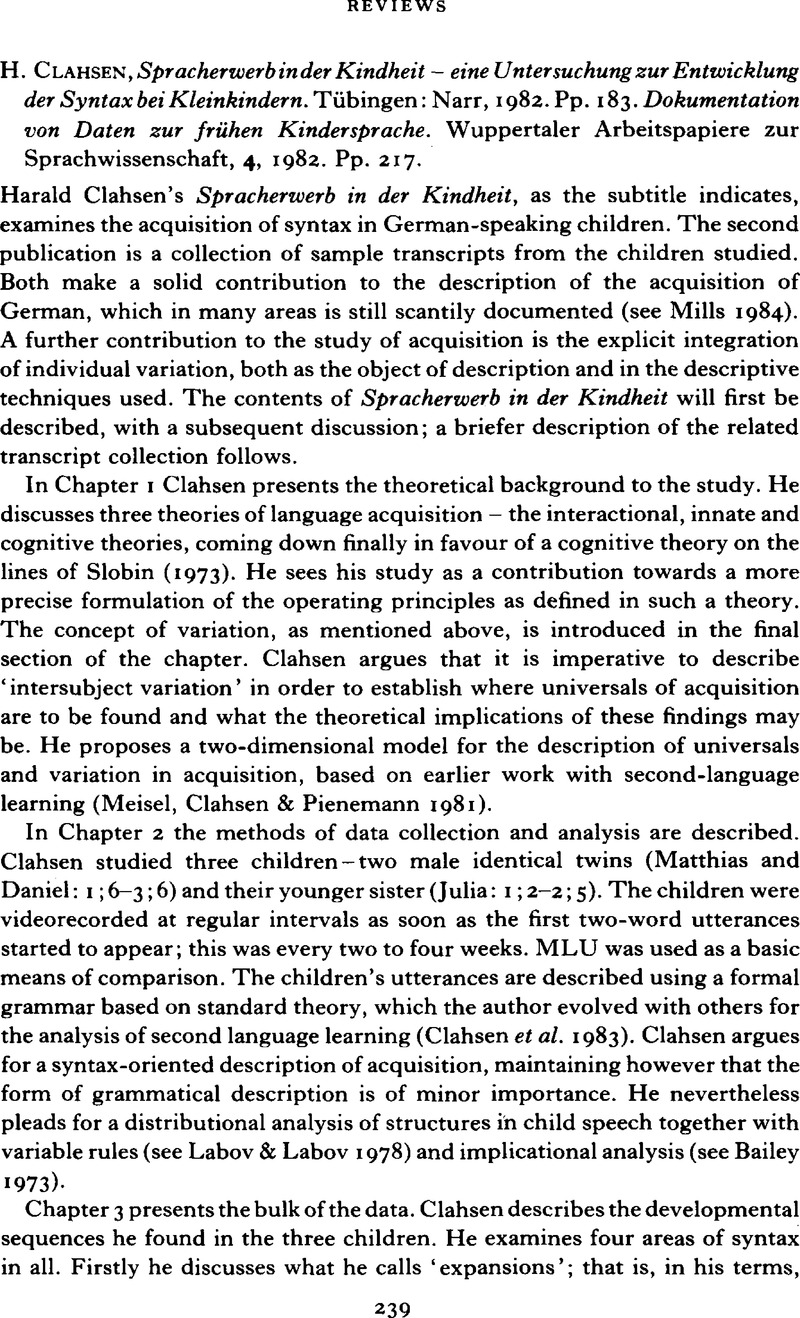No CrossRef data available.
Article contents
Published online by Cambridge University Press: 26 September 2008
Abstract
An abstract is not available for this content so a preview has been provided. Please use the Get access link above for information on how to access this content.

- Type
- Reviews
- Information
- Copyright
- Copyright © Cambridge University Press 1985
References
REFERENCES
Bailey, C. (1973). Variation and linguistic theory. Arlington: Center for Applied Linguistics.Google Scholar
Brown, R., Cazden, C. & Bellugi, U. (1969). The child's grammar from I to III. In Hill, J. (ed.), Minnesota Symposia on child psychology. Minneapolis: University of Minnesota Press.Google Scholar
Clahsen, H., Meisel, J. & Pienemann, M. (1983). Deutsch als Zweitsprache. Der Spracherwerb ausländischer Arbeiter. Täbingen: Narr.Google Scholar
Karmiloff-Smith, A. (1981). Getting developmental differences or studying child development? Cognition 10. 151–8.CrossRefGoogle ScholarPubMed
Labov, W. & Labov, T. (1978). Learning the syntax of questions. In Campbell, R. N. & Smith, P. T. (eds), Recent advances in the psychology of language: language development and mother-child interaction. New York: Plenum.Google Scholar
Levelt, V. J. M., Mills, A. E. & Karmiloff-Smith, A. (1981). Child language research in ESF countries. An inventory. Strasbourg: European Science Foundation.Google Scholar
Lieven, E. V. M. (1980). Different routes to multiple-word combinations. Proceedings of the 1980 Child Language Research Forum. Stanford.Google Scholar
Lieven, E. V. M. (1984). Individual differences. In Slobin, D. I. (ed.), Cross-linguistic study of language acquisition. Hillsdale, N.J.: Erlbaum.Google Scholar
Meisel, J., Clahsen, H. & Pienemann, M. (1981). On determining developmental stages in natural language acquisition. Studies in Second Language Acquisition 3. 109–35.CrossRefGoogle Scholar
Mills, A. E. (1984). The acquisition of German. In Slobin, D. I. (ed.), Cross-linguistic study of language acquisition. Hillsdale, N.J.: Erlbaum.Google Scholar
Nelson, K. (1973). Structure and strategy in learning to talk. Monogr.Soc.Res.Ch.Devel. 38.Google Scholar
Park, T.-Z. (1979). Some facts on negation: Wode's four-stage developmental theory of negation revisited. JChLang 6. 147–51.Google Scholar
Slobin, D. I. (1973). Cognitive prerequisites for the development of grammar. In Ferguson, C. & Slobin, D. I. (eds), Studies of child language development. New York: Holt, Rinehart & Winston.Google Scholar
Slobin, D. I. (1977). Language change in childhood and in history. In Macnamara, J. (ed.), Language learning and thought. New York: Academic Press.Google Scholar
Slobin, D. I. (1984). Crosslinguistic evidence for the language-making capacity. In Slobin, D. I. (ed.), The cross-linguistic study of language acquisition. Hillsdale, N.J.: Erlbaum.Google Scholar
Wode, H. (1977). Four early stages in the development of LI negation. JChLang 6. 87–102.Google Scholar




